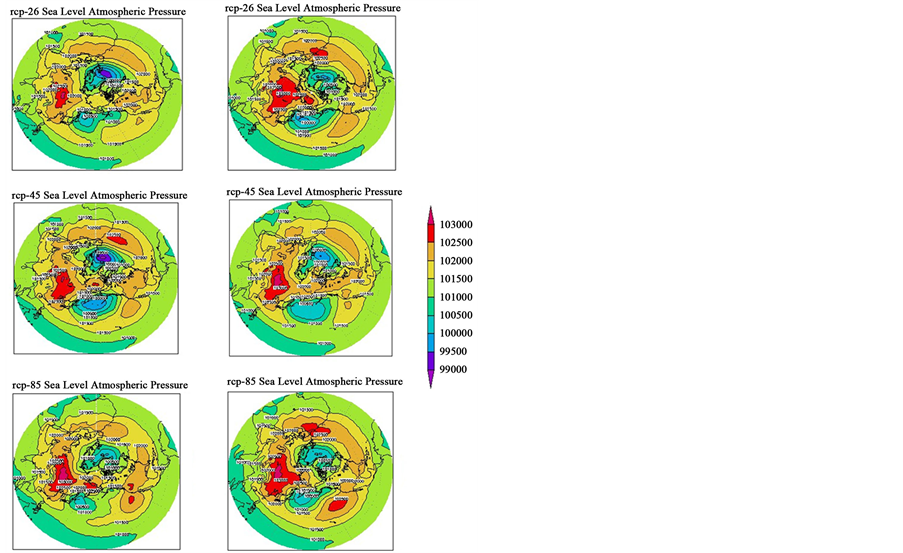1. 引言
根据政府间气候变化专门委员会(IPCC)第四次评估报告 [1] ,由全球地表温度的器测资料得出,1906年~2005年的温度线性趋势为0.74℃,这一趋势大于《第三次评估报告》给出的1901年~2000年的0.6℃的相应趋势。全球温度普遍升高,在北半球高纬度地区温度升幅较大。从20世纪中叶以来,大部分已观测到的全球平均温度的升高很可能是由于人为温室气体浓度增加所导致,许多自然系统正在受到区域气候变化,特别是温度升高的影响。IPCC专家组新归纳总结了用单位面积的辐射强迫来表示未来100 年温室气体排放和气候变化新情景(情景分类见表1),并针对新情景,组织开展了第五次气候变化的数值模拟 [2] 。
北极涛动是北极和北半球中高纬度地区海平面气压跷跷板式振荡的环形模态 [3] ,对于北半球高纬度地区的气候具有显著影响,已经引起了很多气象学者的注意,不但从各个角度研究了北极涛动对于北半球中高纬度地区气候的影响,例如北极涛动异常引起全球变暖 [4] 、北极地区和副极地区域海冰的变化 [5] [6] 、水汽的收支平衡[7] 以及东亚季风异常[8] 等,也研究了近百年北极涛动对中国冬季气候的影响[9] ,以及对中国气候异常变化重要的作用[7] 。大量研究表明北极涛动和北大西洋涛动的年代际趋势对北半球气候变化有很大贡献。
2. 资料与方法
分析资料取自德国马普气象研究所(Max Planck Institute for Meteorology)地球数值模拟系统大气模式分量ECHAM5的输出结果,该模式是国际耦合模式计划(CMIP)的参评模式之一,其测评结果优良,其模拟结果具有高可信度。本文使用此模式三种情景下(RCP2.6, RCP4.5, RCP8.5)的逐月海平面气压场(SLP)资料,时间跨度为2006年到2100年,空间分辨率为1.875 × 1.865。北极涛动在冬季信号最强,故取12-2月的资料。
对于北极涛动的定义,本文参考Thompson [5] 等的作法,利用经验正交函数(E0F)分析方法,对北半球北纬20度以北月平均海平面气压距平场进行分解,取第一模态对应的时间系数为北极涛动指数(AOI)。分析所用方法包括经验正交分解、九点二次平滑滤波,小波分析,交叉谱分析等。
3. 结果分析
3.1. 冬季北半球海平面气压场空间特征分析
对RCP2.6、RCP4.5、RCP8.5三种情景下2006~2099年冬季北纬20度以北海平面气压距平场(Slpa)进行EOF分解(图1),第一模态均表现出明显的极地气压下降,而中高纬度气压上升的“跷跷板”变化结构,环状模态也很明显。三种情景下第一主模态的方差贡献率依次为45.79%、46.47%、45.25%。中高纬地区的正气压距平中心主要位于西欧大陆和北大西洋地区,以及北太平洋地区。值得注意的是,在

Table 1. Types of representative concentration pathways
表1. 典型浓度路径特征(林而达等[2] )

 (a) (b)
(a) (b) (c)
(c)
Figure 1. Spatial pattern of the first EOF mode wintertime mean Slpa in RCP2.6 (a), RCP4.5 (b), and RCP8.5
图1. 以上三张图分别为ECHAM5模式输出数据RCP2.6、RCP4.5、RCP8.5情景下对20˚N以北的2006~2099年冬季海平面气压距平场进行EOF分解的第一模态图
RCP4.5情景下,北大西洋正距平中心强度明显高于其他两种情景下的强度。在RCP2.6、RCP4.5情景下,负中心偏向东半球。而在RCP8.5的情景下,负气压距平区域出现了两个负中心,一个偏向于东半球,另一个偏向于西半球。
3.2 北极涛动指数的特征分析
对北极涛动指数进行小波分析发现(图2),RCP2.6情景下,北极涛动主要是2~3a周期。RCP4.5情景下,北极涛动在2030年以前主要是4~6年周期,此后变化周期逐渐拉长,准四年周期震荡逐渐减弱,2040~2070年出现较强的8年周期。RCP8.5情景下,2030~2050年出现准4年周期。用功率谱对三个序列进行周期分析发现,三个北极涛动指数序列均无通过检验的周期。图(2a)、图(2b)、图(2c)中的黑色曲线为RCP2.6,RCP4.5,RCP8.5三种情景下2006~2099年北极涛动的时间序列图,可以得出,RCP2.6情景下,冬季北极涛动指数振幅分别在21世纪10年代、60年代、70年代、90年代达到极大值,40年代、90年代落回极小值。从图2(a)中9点二次平滑曲线(绿色曲线)可以得出,从21世纪10年代中期到40年代初期,北极涛动指数平均值一直低于94年平均值;而40年代末到60年代中期,北极涛动指数平均值一直高于94年平均值;60年代中期到90年代末,北极涛动指数平均值一直低于94年平均值。RCP4.5情景下,从图2(b)中9点二次平滑曲线可以得出,在21世纪20到60年代,冬季北极涛动指数长期处于负相位;而在60到80年代初以及90年代,北极涛动指数处于正相位,且正相位明显强于负相位。RCP8.5情景下,冬季北极涛动指数振幅极大值出现在30 和60年代(如图3)。进行回归分析发现,北极涛动指数的线性趋势依次为0.027/10a、0.032/10a和−0.018/10a,前两种情景北极涛动指数的变化趋势相近,辐射

 (a) (b)
(a) (b) (c)
(c)
Figure 2. (a) The time series of AOI and the twice nine-point filter line in RCP2.6; (b), (c) the same as (a), but in RCP4.5 and RCP8.5
图2. RCP2.6,RCP4.5,RCP8.5三种情景下2006~2099年北极涛动指数时间序列图,绿色曲线为9点二次平滑后的曲线

 (a) (b)
(a) (b) (c)
(c)
Figure 3. Wavelet power spectrum of AOI in RCP2.6 (a), RCP4.5 (b) and RCP8.5 (c), red lines are denoting the influence region
图3. RCP2.6、RCP4.5、RCP8.5三种情景下北极涛动指数的小波分析图,红色弧线代表影响域
强迫最强、二氧化碳浓度最高的RCP8.5情景北极涛动指数的变化趋势却恰恰相反。
3.3. 西北地区的冬季气温
图4给出了2006年~2100年冬季我国西北地区温度的标准化曲线。
从图4(a)上可以看出,在rcp-2.6情况下,未来95年我国西北冬季气温表现出明显的年代际特征。2006~2040年,基本上以负距平为主,对应西北冬季气温偏低;之后至2070年基本上以正距平为主,表明西北冬季气温偏高;2070~2100则基本上以负距平为主,对应西北冬季气温偏低。
从图4(b)可以看出,在rcp-4.5情况下,2006~2035年,基本上以负距平为主,对应西北冬季气温偏低;之后至2075年以正距平为主,但是变化不大,表明西北冬季气温基本正常;2075~2100年,则基本上以正距平为主,表明西北冬季气温偏高。成为未来95年来西北冬季气温最暖的一段时期。
从图4(c)可以看出,在rcp-8.5情况下,可以明显的看出,2006~2060年以负距平为主,但是曲线是呈上升趋势,表明西北冬季气温上升;2060~2100年,以正距平为主,曲线也是呈上升趋势,表明西北冬季气温偏高且气温上升。
从图4(a)、图4(b)、图4(c)对比来看,随着温室气体排放量的增大,西北地区冬季气温也随之升高。
3.4. 北极涛动与西北地区冬季气温的关系
在rcp-2.6情况下,从海平面气压合成图上可以看出(图5(a)~图5(b)),在北半球中高纬度存在4个大气中心。在东亚太平洋地区,北极涛动指数大的年份西伯利亚高压比北极涛动指数小的年份弱,等压线梯度小于北极涛动指数小的年份,即北极涛动指数大的年份东亚太平洋地区海平面气压梯度小,北极涛动指数小的年份东亚太平洋地区海平面气压梯度大,也就是说北极涛动指数大的年份东亚冬季风强度偏
 (a) (b)
(a) (b) (c)
(c)
Figure 4. The time series of winter temperatures and the twice nine-point filter line
图4. 西北冬季气温指数曲线(圆圈)、及高斯 9点平滑线(曲线)

Figure 5. The Sea level pressure field (a, b, c, d, e, f)
图5. 海平面气压场(从左到右,从上到下依次是a,b,c,d,e,f)
弱,北极涛动指数小的年份东亚冬季风强度偏强;而阿留申低压比北极涛动指数小的年份强,中心值约低5 hPa。
在rcp-4.5情况下,在东亚太平洋地区,北极涛动指数大的年份西伯利亚高压比北极涛动指数小的年份弱,等压线梯度小于北极涛动指数小的年份,中心高压范围明显小于北极涛动指数小的年份;而阿留申低压比北极涛动指数小的年份强,中心值约低5 hPa。
在rcp-8.5情况下,在东亚太平洋地区,北极涛动指数大的年份西伯利亚高压和北极涛动指数小的年份差别不大。
4. 结论
基于德国马普气象研究所(Max Planck Institute for Meteorology)政府间气候变化专门委员会第五次评估报告地球数值模拟系统大气模式分量ECHAM5的输出结果,对RCP2.6、RCP4.5和RCP8.5三种情景下21世纪北极涛动(AO)的变化特征进行探究,发现:
1) 对冬季北纬20度以北海平面气压距平场进行EOF分解发现,在RCP4.5情景下,北极涛动模态北大西洋正距平中心强度明显高于其他两种情景下的强度。在RCP2.6、RCP4.5情景下,负中心偏向东半球。而在RCP8.5的情景下,负气压距平区域出现了两个负中心,一个偏向于东半球,另一个偏向于西半球。三种情景下北极涛动指数的周期都随时间变化较大,在整个94年时间尺度上无固定的显著周期。
2) 未来95年西北地区冬季气温在rcp-2.6情况下,西北地区冬季气温大约可分为3个时段:2006~2040年冬季偏冷,2040~2080年冬季偏暖,2080~2100年冬季偏冷;在rcp-4.5情况下,2006~2040年冬季偏冷,2040~2100年冬季偏暖;在rcp-8.5情况下,未来95年西北地区冬季温度持续上升。
3) 通过对北极涛动指数极值年份对海平面气压场进行了物理解释,从而得出北极涛动指数与我国西北地区冬季温度的一种联系:在rcp-2.6和rcp-4.5情况下,北极涛动指数大的年份,西伯利亚高压减弱,西伯利亚高压东南部、阿留申低压西南部东北风强度减弱,东亚及太平洋地区间的海平面气压梯度减小,东亚冬季风强度偏弱,我国西北地区冬季温度偏高;而北极涛动指数小的年份,西伯利亚高压增强,西伯利亚高压东南部、阿留申低压西南部东北风强度增强,东亚太平洋地区海陆海平面气压梯度加大,东亚冬季风强度偏强,西伯利亚高压增强,同时日本海附近低压减弱,致使冷空气南下进入东北地区,偏北冬季风增强,东北气温降低我国东北地区冬季温度偏低。而在rcp-8.5情况下,这种对应关系不是非常显著。